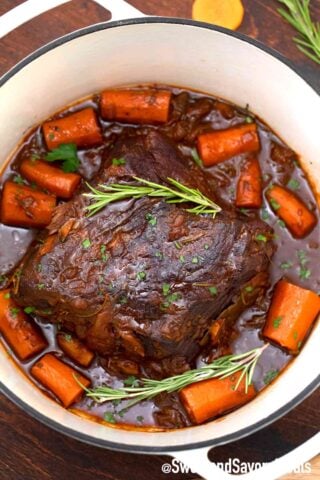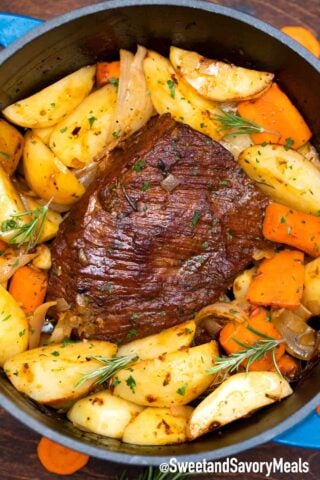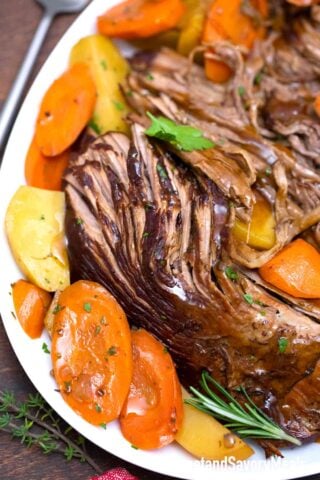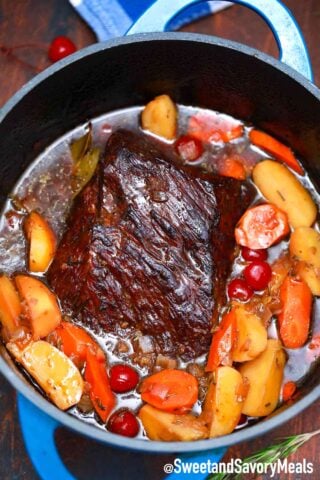German Pot Roast
I find it deeply comforting to pour a brown ale over a beef chuck and cook it to tender perfection. This is all about this German Pot Roast, which has been braised until it falls apart into flavorful, juicy chunks of meat. This is the ideal set-it-and-forget-it dinner that is effortlessly impressive, and it will make your house smell amazing.
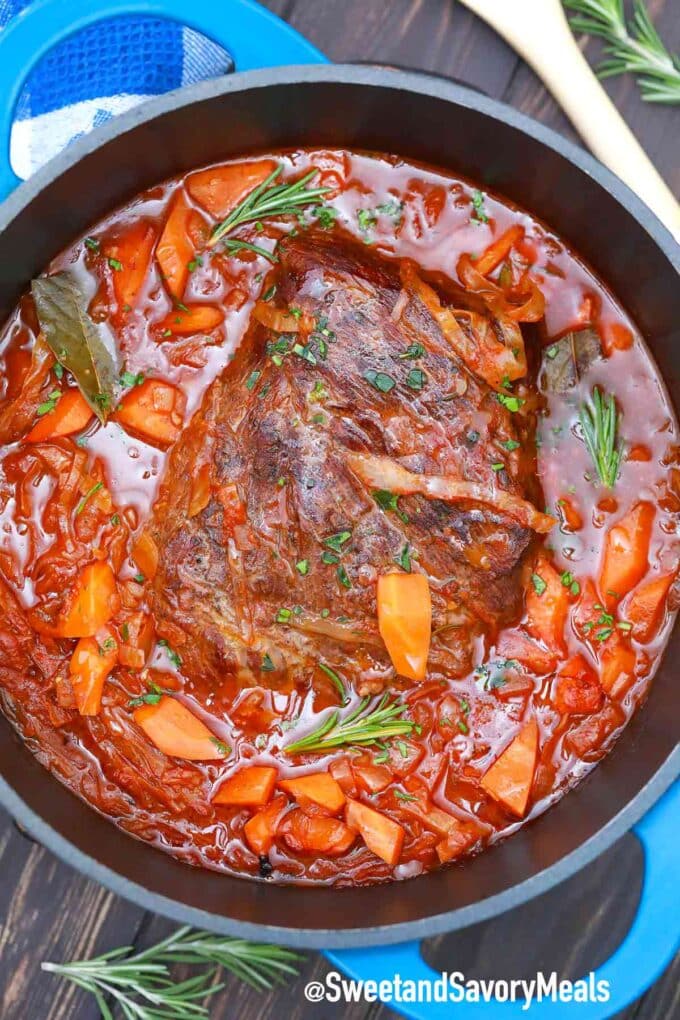
Pot roasts are my soul food; I love how, with minimal effort, they deliver maximum flavor. They are fancy enough for special occasions yet so fuss-free that they can be easily prepared for a weeknight family dinner. My family loves it when I make this spectacular, melt-in-your-mouth red wine pot roast or my ultimate Mississippi pot roast. Served over mashed potatoes, these are the kind of dishes that create memories.
Table of contents
This German pot roast or sauerbraten is effortlessly impressive, rich, tender, and with just the right amount of tanginess. Green cabbage is simmered low and slow with the meat, soaking up all the delicious flavors and completing the meal beautifully. The roast tastes even better the next day after all the flavors have had a chance to meld together. The leftovers reheat nicely, allowing you to enjoy a cozy, homemade meal again.
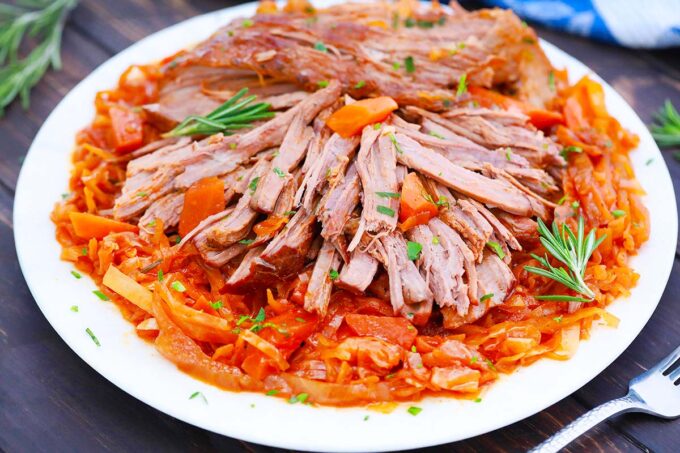
Why you will love this recipe
- This is a truly unique roast: For those looking to try a different kind of roast, rather than the typical meat and potatoes (there are no potatoes in this), this German pot roast is flavored with ingredients you won’t usually see in a pot roast. But each one of them adds a whole other dimension of delicious flavor.
- No marination needed: I braise it for five hours at a low temperature (without a slow cooker), so there is no reason for a messy marinade. There is no reason not to do one, though, if that is your thing. However, with my recipe, the seasonings and flavors are seared into the meat, and it is braised for five hours in a delectable bath.
- Make a scrumptious gravy: The gravy that comes from this pot roast is award-winning. Seriously, pour it into a gravy boat, a mason jar, or simply a bowl, and let everyone soak their meat as much as they want. Thicken it or don’t. Either way, it is terrific.
- Serve a crowd: If I want to serve a crowd, I either get a larger chuck roast or buy two of them. Then, I double the rest of the ingredients and the cooking time. Everything fits well in the pot. If not, I use two pots. I have a dishwasher, so I don’t mind.
What you will need
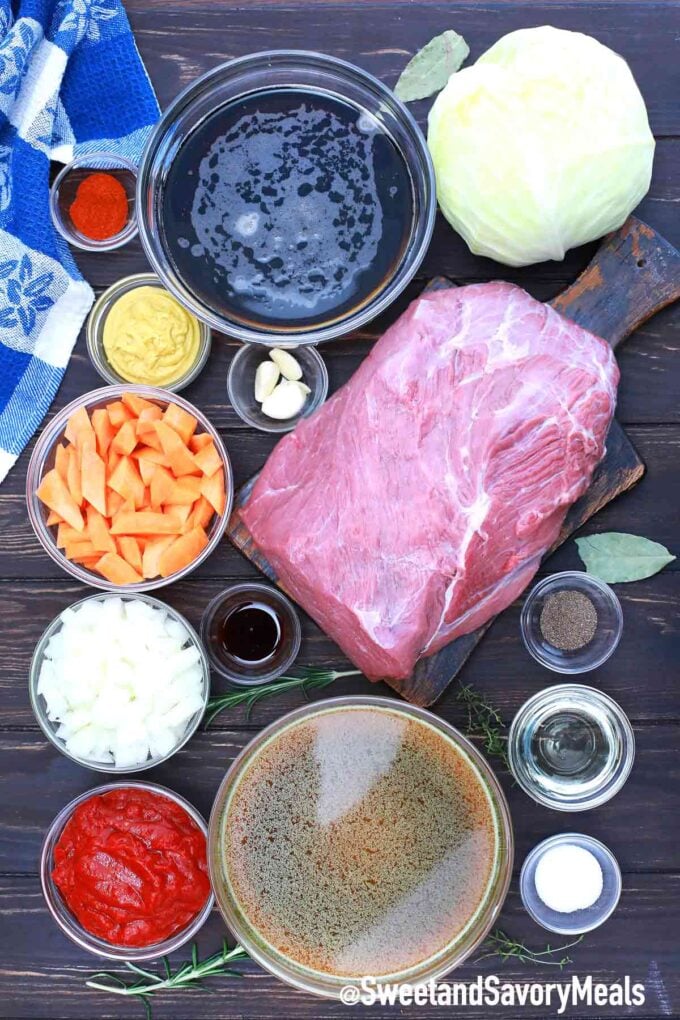
- The roast: Chuck roast is my favorite cut of beef for this recipe because it is full of cartilage, which melts into a luscious flavor. It also tenderizes and makes the meat succulent.
- Veggies: I use green cabbage and carrots for this roast, cut into big chunks.
- Liquids: The main ingredient here is brown ale. I also use tomato paste, Worcestershire sauce, German mustard, and low-sodium beef stock.
- Aromatics: I use fresh, minced garlic and chopped white onions as my aromatics to achieve a bold flavor and aroma.
- Seasonings: Just salt and pepper for this roast. Most of the flavor comes from the liquids, aromatics, and herbs.
- Herbs: For added layers of flavor, I include smoked paprika, thyme sprigs, rosemary sprigs, and bay leaves.
How to make
Preheat the oven: First, I preheat the oven to 300 degrees F. Then, I season the chuck roast on all sides with salt and pepper.
Sear the beef: Now, I place a Dutch oven with oil over medium-high heat and wait for it to heat up. Once it is hot, I sear the beef for three minutes on each side. Then, I remove the roast and turn the heat to medium.

Add veggies: At this point, I add the garlic, carrot, onion, and paprika, stirring for three minutes. The tomato paste is added next, and I stir and cook for an additional three minutes.
Make the sauce: Next, I stir in the beer, scrape the bottom of the pot, and bring it to a boil. Then, I reduce it to low and let it simmer for five minutes. Now, the mustard, beef stock, and Worcestershire sauce get stirred in before I add the meat back to the pot.

Cook and serve: Finally, I place the bay leaves, thyme, and rosemary sprigs on and around the beef before covering the pot and putting it in the oven for four hours. After four hours, I top the roast with the cabbage and cook it for another hour or until the cabbage has softened and the roast is fork-tender. Let it rest for 15 minutes before serving.
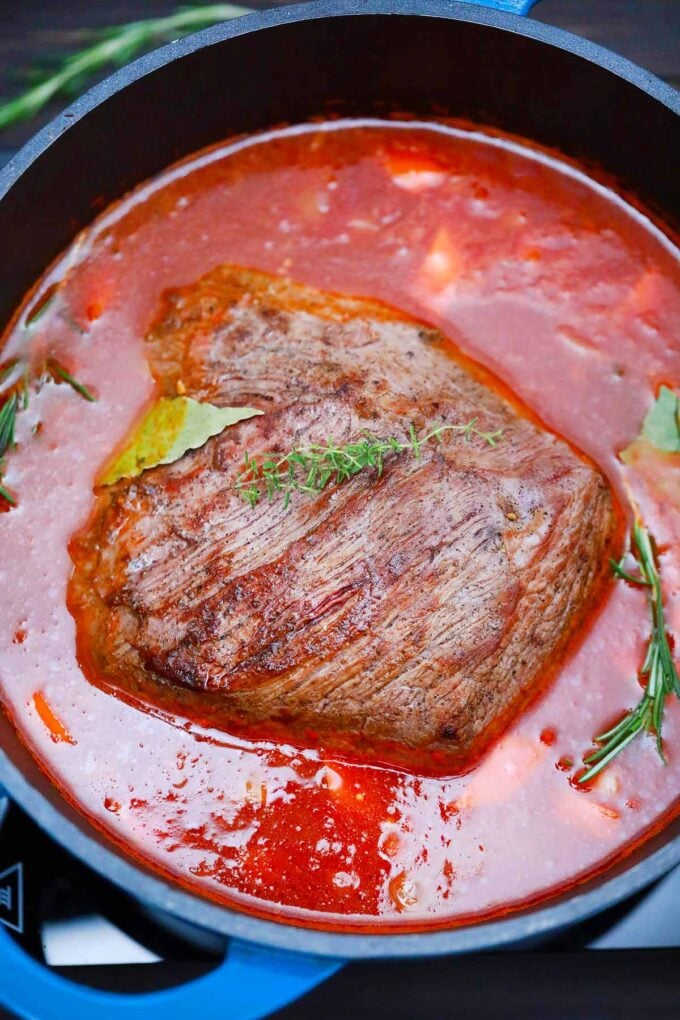
Expert tip
Using new ingredients
I enjoy experimenting with new ingredients in my recipes. The brown ale and German mustard are not standard in many households. I did some research for you. Some of the top brown ale include Humboldt Brown Hemp, Brooklyn Brown Ale, and Maduro Brown Ale. Humbolt is dry and creamy with a chocolatey malt taste of dried fruit. Brooklyn has a pure, grainy flavor. And Maduro is rich and creamy, brewed with oatmeal.
The top three German mustards are Lowensenf, Koops, and Alstertor Dusseldorf Style. I only use Lowensenf Medium because the hot stuff is way too spicy. It is premium mustard, which is my favorite because it is pure and clean. Koops has a sweeter and sourer taste, which may be more suitable if that is the desired style. Alstertor is similar to Dijon-style mustard but with a more pungent flavor. I suggest a taste test for any mustard brand.
More tips to consider:
- Choose a chuck brisket or round roast with the most marbling for the best flavor and moistest meat.
- Don’t be afraid to get a large chunk of meat. It can always be cut into two or three pieces to fit into the pot.
- Be sure to sear the beef. It locks in the juices and caramelizes the outside for a wonderful, crispy crust.
- Instead of shredding the cabbage, cutting it into chunks is fine, too, but add it about an hour sooner.
- Always deglaze the pan to keep the meat from burning and add flavor to the roast.
- Make sure to taste new ingredients, such as beer and German mustard, before adding them to the roast.
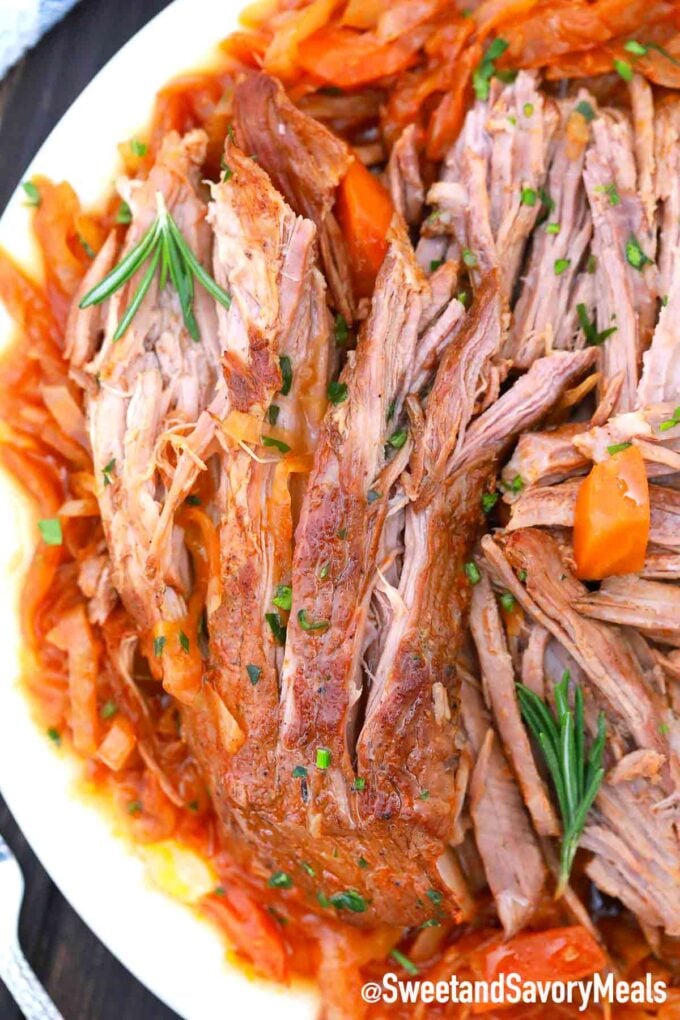
Recipe variations and add-ins:
- Bacon roast: Everyone loves it when I add some bacon. I fry it first, pat out the grease, chop it into chunks, and let it simmer with the roast.
- No ale: Instead of ale, I sometimes use root beer, wine, Coke, or Dr. Pepper.
- Instead of German mustard: For those who do not like the heat of German mustard, try Dijon mustard.
- Add some taters: Since we’re accustomed to having potatoes in our pot roasts, I often include some baby reds to please the family.
- Include other vegetables: For an extra tangy flavor, try adding pickles to the braise. Mushrooms, cloves, celery, and potatoes are also great additions.
- Hot and spicy: To make this a spicy pot roast, toss in some jalapenos and red pepper flakes.
Serving suggestions
I always serve my roast with some bread, whether it’s just a loaf of crusty French bread or my special, fluffy dinner rolls. Another of my favorite appetizers to serve with this delicious entrée is my fried cheese sticks. My favorite wines to pair with this pot roast are Pinot Blanc, Riesling, Gewurztraminer, and Chardonnay. The roast is perfect over mashed potatoes, mashed cauliflower, or mashed sweet potatoes.
The kids enjoy this with my cranberry mocktail because of its blend of cranberry sweetness and tanginess, complemented by the sweet pomegranate and mint. For a dessert to complement the rich and heavy pot roast, I like to serve this refreshing German apricot cake. On special occasions, I also make German chocolate cupcakes or German chocolate poke cake.
How to store leftovers:
- Refrigerate: Leftovers can be stored in an airtight container in the refrigerator for up to three days.
- Freezing: To freeze, put it in a freezer-safe container for up to three months.
- Defrost: Thaw overnight in the refrigerator for the best flavor.
- Reheating: To reheat, place the item in a preheated oven at 350°F for 15 minutes or in the microwave for 45 to 60 seconds.
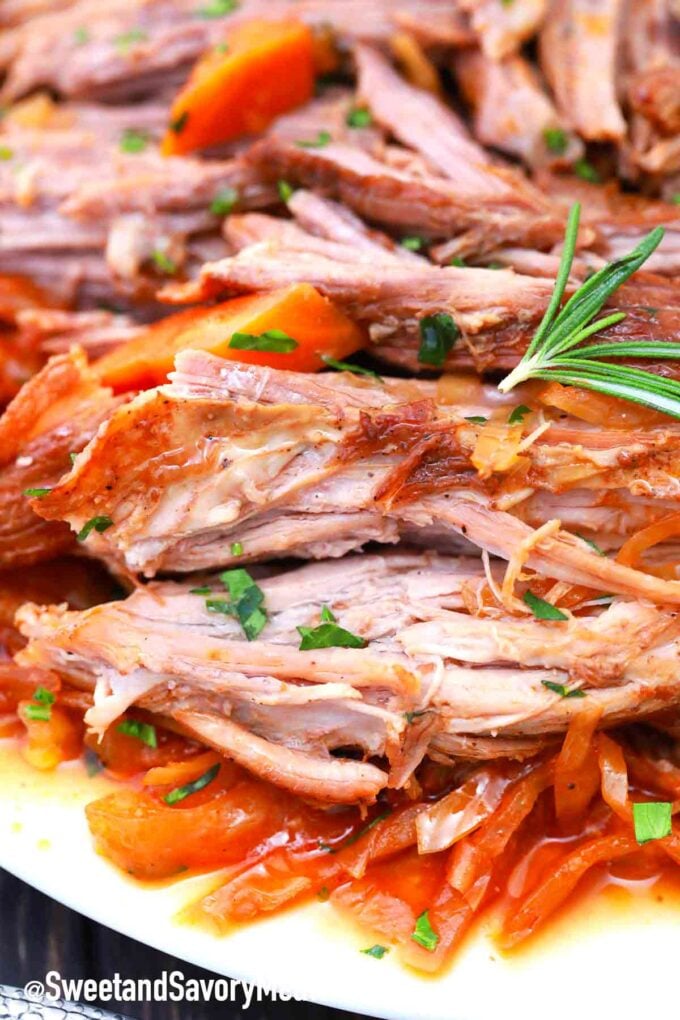
Frequently asked questions
The most common reason is that it has not been cooked long enough for the collagen to break down. If it has not melted, the meat will be tough. Continue cooking it until the meat is tender. Another problem would be using the wrong cut of meat. I always use chuck roast because it has the most collagen, but other tough cuts of meat will work. Just do not use lean cuts like ribeye or filet mignon.
Browning (or searing) the roast not only adds color but also caramelizes the meat. This is known as the Maillard reaction, a chemical process that occurs when proteins are cooked at high temperatures. The sugar and amino acids caramelize at higher temperatures, adding a delicious taste and sealing in the juices, which keeps the meat juicy and tender.
Deglazing is necessary to remove the browned bits of meat stuck to the bottom of the pan from searing the beef. I like to deglaze the pot with beer to add a robust flavor to the roast. Not only does the beer enhance the flavor, but it also soaks the browned bits with beer, adding a whole new dimension of flavor that elevates the broth to another level of deliciousness. Broth or another liquid can also be used for deglazing, though.
It could be the beer. Be sure to taste it first. If it doesn’t have a good flavor, don’t use it. Some people dislike the flavor of brown ale. I always taste the ingredients I use before adding them, mainly if I’ve never used them before. The same applies to German mustard. Whenever there is a new ingredient you’re unsure of, it’s essential to taste it before adding it to the pot, just in case the flavor is something that will turn the whole dish bitter or sour.
More pot roast recipes to try:
Loved this recipe? I’d love to hear from you! 💛 Leave a 5-star rating ⭐️ in the recipe card below and share your thoughts in the comments – I read and appreciate every single one!
Let’s stay connected! Follow me on Facebook, Instagram, Pinterest, and YouTube for more delicious, sweet and savory recipes. Have a question? Ask in the comments, and I’ll be happy to help! 😊 with love Catalina!
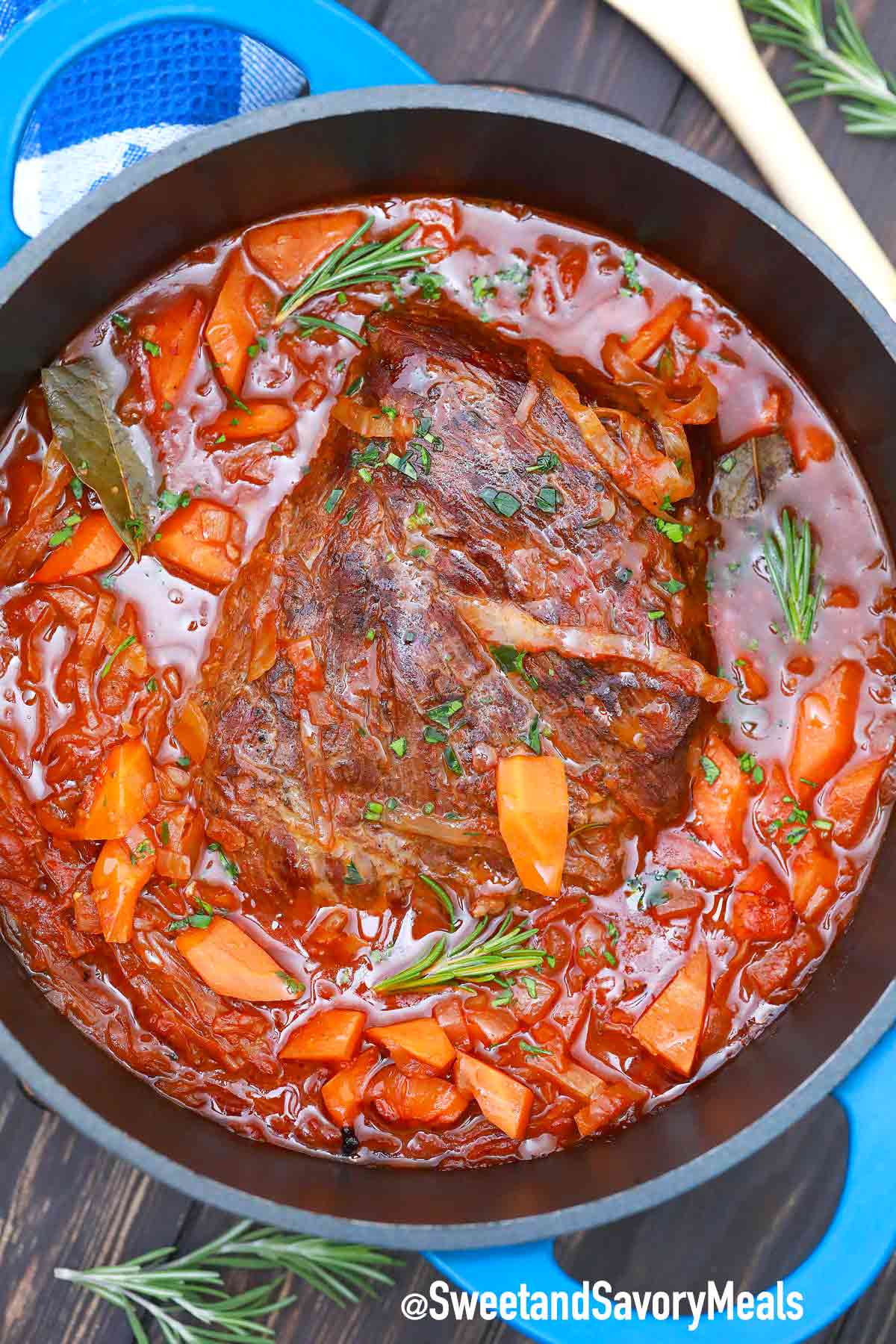
German Pot Roast with Cabbage
Ingredients
- 4 pounds beef chuck roast
- 2 teaspoons salt
- 1 teaspoon pepper
- 1 teaspoon smoked paprika
- 2 tablespoons vegetable oil
- 1 large onion cut into chunks
- 4 cloves garlic
- 3 carrots peeled and cut into chunks
- 4 sprigs thyme
- 4 sprigs rosemary
- 2 bay leaves
- 6 ounces can tomato paste
- 1 bottle brown ale
- 1 tablespoon Worcestershire sauce
- 1/2 cup German mustard
- 4 cups beef stock
- 1 small head of green cabbage cut into ribbons
Instructions
- Preheat oven to 300 degrees F.
- Season chuck roast on all sides with salt and pepper.
- Place a Dutch oven over medium-high heat, add oil, and once hot, add the roast. Sear it on both sides until nicely browned. Remove the roast from the pan and set it aside.
- Turn the heat to medium and add the onion, garlic, and paprika. Stir, then add the carrot. Sear for 3 minutes, then stir in the tomato paste and cook for three more minutes.
- Stir in beer, and scrape the pan bottom to “deglaze” it. Bring the mixture to a boil, then reduce the heat to low and simmer for 5 minutes.
- Stir in the mustard, Worcestershire sauce, and beef stock. Return the chuck roast to the pan and add the thyme, rosemary, and bay leaves. Cover with lid.
- Place in oven and braise for 4 hours.
- Top the roast with the cabbage and braise for an additional hour or until the cabbage has softened and the roast is fork-tender.
- Garnish with parsley and serve.
Video

Notes
Using new ingredients
I enjoy experimenting with new ingredients in my recipes. The brown ale and German mustard are not standard in many households. I did some research for you. Some of the top brown ale include Humboldt Brown Hemp, Brooklyn Brown Ale, and Maduro Brown Ale. Humbolt is dry and creamy with a chocolatey malt taste of dried fruit. Brooklyn has a pure, grainy flavor. And Maduro is rich and creamy, brewed with oatmeal. The top three German mustards are Lowensenf, Koops, and Alstertor Dusseldorf Style. I only use Lowensenf Medium because the hot stuff is way too spicy. It is premium mustard, which is my favorite because it is pure and clean. Koops has a sweeter and sourer taste, which may be more suitable if that is the desired style. Alstertor is similar to Dijon-style mustard but with a more pungent flavor. I suggest a taste test for any mustard brand.More tips to consider:
- Choose a chuck brisket or round roast with the most marbling for the best flavor and moistest meat.
- Don’t be afraid to get a large chunk of meat. It can always be cut into two or three pieces to fit into the pot.
- Be sure to sear the beef. It locks in the juices and caramelizes the outside for a wonderful, crispy crust.
- Instead of shredding the cabbage, cutting it into chunks is fine, too, but add it about an hour sooner.
- Always deglaze the pan to keep the meat from burning and add flavor to the roast.
- Make sure to taste new ingredients, such as beer and German mustard, before adding them to the roast.

